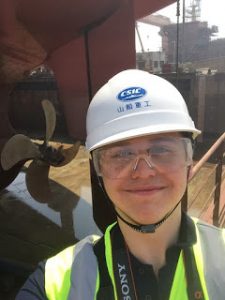The marine imaging workshop 2017 in Kiel was the second workshop of this kind, bringing together engineers, researchers regulators, and industrial partners who are involved in acquiring visual imagery in the marine realm. To represent the engineering side of this challenge, Dr Blair Thornton and Sophia Schillai travelled to the GEOMAR Helmholtz Centre for Ocean Research in Kiel; Blair presented how he uses classical photography in combination with structured light from a laser to produce multi-hectare 3D Visual Maps that can be used to quantify the distribution of benthic organisms. Sophia brought a poster on the terrain following challenges for flight style AUV.

Besides presentations the workshop included several sessions for discussions on the future of marine imaging, giving a large and diverse platform to exchange what is important to those who use the data and where the challenges in aquiring and processing the data lie.
This was rounded off by a tour of the GEOMAR facilities, where on top of a diverse spectrum of research areas they were amused by the discovery of a museum model of the AUV ABYSS. It was made for a special exhibit, on of many ways how Germany involves the public in the science theme of 2017: The year of the oceans.
Shortly afterwards the annual VLC awayday conference brings together all students whose research is with the ECS group Vision, Learning, and Control (VLC). This includes several PhD students with FSI, but this year our group was also represented by Dr Blair Thornton giving the keynote. He showed how the often quite abstract research on Vision, Learning and Control is vital to getting a larger scale insight to the oceans. They cover 70% of our planet, but challenges from analysis of deep sea minerals to discovering deep-sea benthic ecosystems or monitoring the environment following disasters such as the Fukushima nuclear accident can only be solved at a large scale by applying advanced computational techniques.
PhD student Sophia completed the insight in the collaborative work between FSI and VLC by showing her work on improving the capability of flight style AUV, like Autosub6000 or BoatyMcBoatface from NOC, to stay close to complex terrains for photographic studies. Her presentation was awarded the runner-up award for the best presentation of the day.
Monthly Archives: June 2017
OCEANS IV
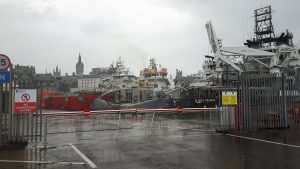
Between the 19th and 22nd June the FSI group was represented by PhD students Yu Cao and Bernat Font Garcia, as well as postdoctoral researches Francesco Giorgio-Serchi and Artur Lidtke at the Oceans ’17 conference in Aberdeen, Scotland.
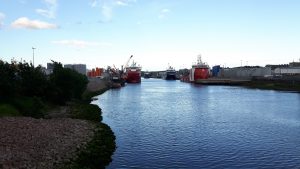
The event covered a very wide range of topics, from aquaculture, sensor technologies through to signal classification along with many more applied papers relevant to offshore structures and renewable energy. The papers presented by FSI researchers included a study of a mixed renewable energy scavenging device for an autonomous vehicle (Yu Cao https://pure.soton.ac.uk/admin/files/23591223/161201_132.pdf), development of a turbulence model for application to vortex induced vibration on riser pipes and moorings (Bernat Font Garcia https://www.researchgate.net/publication/316734503_Analysis_of_two-dimensional_and_three-dimensional_wakes_of_long_circular_cylinders), testing of a soft robot utilising shape change to propel itself (Francesco Giorgio-Serchi https://eprints.soton.ac.uk/410902/1/GiorgioSerchi_Weymouth_Oceans2017.pdf), and an experimental study of laminar flow effects on an underwater glider wing (Artur Lidtke https://eprints.soton.ac.uk/411106/).

The conference was also preceded by a day of workshops and tutorials devoted to modelling marine renewable energy devices and design of autonomous underwater vehicles (AUV). Both subjects of significant interest to many within FSI.
Summer Open day opportunities – learn more about ship science, naval architecture and marine engineering
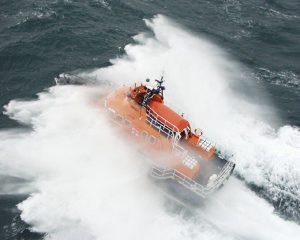
For many the maritime sector is not one they may know much about but there are many exciting careers in the industry, with plenty of opportunities to travel, work abroad and not just to always sit behind a desk at a computer. Our graduates are highly sought after in the industry and can be found in leadership positions worldwide and across a range of sectors from cruise ships, America’s Cup team, offshore industry, ship design and consultancy, marine renewables, defence sector, academia and even Silicon Valley. We are the only degree programme in the UK which is accredited by the Royal Institution of Naval Architects, Institute of Marine Engineering, Science and Technology, and the Institution of Mechanical Engineers. There are exciting engineering challenges in the maritime sector from how do we decarbonise shipping, protect lives at sea, maritime robotics, develop cost effect marine energy harvesters for wind, wave and tide to name but a few.
For those studying hard at school who are interested in the maritime engineering sector we have four open days this summer. Staff and students will be on hand to answer questions and show some of our facilities and educational experience. Our degree course cover a wide range of the maritime sector and provide great flexibility. We look for strong grades in maths and a suitable science such as physics, chemistry or further maths. Our admissions team is always happy to answer question either by email or phone.
This summer’s University open days are taking place on Saturday 8th July, Saturday 9th and Sunday 10th September and Saturday 14th October. To book for the 8th July or register an interest and find out more http://www.southampton.ac.uk/about/visit/open-days.page . It will be great to meet you and explain more.
Part 2 Ship Science Students Tour China's Maritime Sector

For the second year our second year ship science students have been able to visit ship yards and maritime organisations in China on a 10 day whistle stop tour. The opportunity to visit a variety of ship yards building ships, performance yachts, offshore platforms as well as some of the leading maritime universities and research organisations has been made possible because of a number of on-going educational partnerships between the Faculty of Engineering and Environment and our colleagues in China,
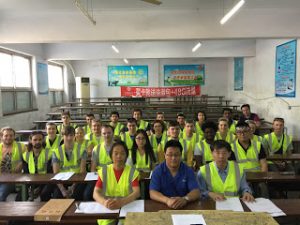
If you want to find out more please find our direct from the student’s blog at csiv2017.blogspot.com. There are some great shout outs to Dr Boyd’s ship production course being seen in action and my personal favourite about the need to reduce the drag of ship rudders..
